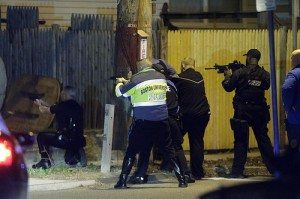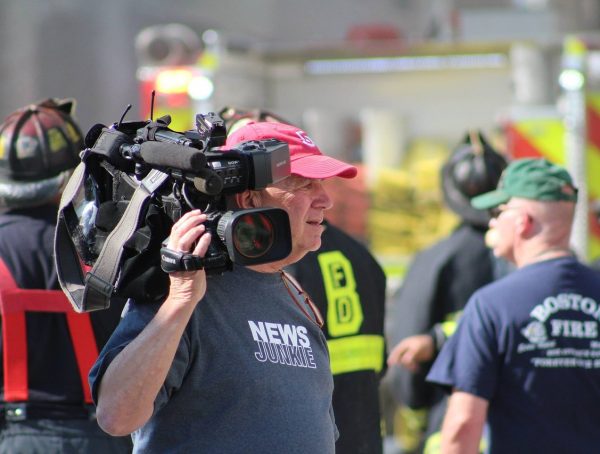 Journalists reacted to the bombings at the Boston Marathon and the aftermath the way they always do: they ran toward danger. In a crisis, whether it’s terrorism or a manhunt in Boston or a fertilizer plant explosion in Texas, the news media are first responders. In order to do their job well, however, journalists must focus not only on the story but on their own safety. If they endanger themselves, they may compromise the news organization’s ability to inform the public.
Journalists reacted to the bombings at the Boston Marathon and the aftermath the way they always do: they ran toward danger. In a crisis, whether it’s terrorism or a manhunt in Boston or a fertilizer plant explosion in Texas, the news media are first responders. In order to do their job well, however, journalists must focus not only on the story but on their own safety. If they endanger themselves, they may compromise the news organization’s ability to inform the public.
Unlike other first responders, most journalists haven’t been trained on how to stay safe. Many newsrooms do provide training for journalists who may be sent into hazardous situations like war zones, but disaster can strike anywhere at any time. Before it hits the community you cover, please check these tips and develop your own safety plan.
Be prepared. Disaster scenes are chaotic and stressful. When news breaks, if you don’t have it with you there’s no chance you’ll get it in time. Make sure you have a well-stocked run bag with you at all times, including a basic first aid kit.
Be aware. Reporter Laura Krantz was covering the finish of the Boston Marathon but missed the bombings because she had gone to charge her cellphone. When she returned, police were trying to clear the area. It didn’t occur to her that there could be more explosions. “I thought they just wanted the reporters to go away,” Krantz says. “You just go into reporter mode. You don’t really think about yourself.” You should.
Protect yourself. Flak jackets provide some protection in dangerous situations. Wear them, if available, but don’t let them make you feel invulnerable. Gas masks or protective suits are not designed to let a person stay at a hazardous scene. Experts say they are mostly useful for getting away alive. Because gases are heavier than air, avoid low-lying areas when covering a chemical spill or attack. Stay upwind.
Avoid becoming a target. If covering riots or violence, don’t go in with a marked news vehicle and keep TV lights off. Don’t interfere with law enforcement or rescue efforts. Display your credentials.
Pay attention. Journalists should be aware of their surroundings and stay as portable as possible, so they can move quickly, if necessary. Be alert for unusual sounds, such as loud pops, and for unexpected sights—does someone appear to be in the wrong place or doing something unusual? If reporters hear gas or vapor escaping, they are probably too close to a scene. If they can smell a pungent odor, they may have been exposed to a chemical hazard and may be contaminated; they should leave immediately. The U.S. National Academies has concise fact sheets on biological, chemical, nuclear and radiological threats that reporters may want to print out and carry with them.
Limit exposure. Do not smoke at a disaster scene. Gas lines may crack and downed power lines may still carry current during natural disasters. Avoid eating or drinking at the scene if there is any chance of chemical or biological hazards; these can contaminate food and drink.
Stay in touch. Journalists in the field should make sure at least one person, usually a supervising editor, knows where they are at all times, who they are meeting with, and when they are expected to return. That person should have a list of your emergency contacts and should know what to do if the journalist does not check in as expected.
Take a break. Long-running stories can be exhausting. Phillip Williams of the Australian Broadcasting Company says he wore himself out covering the Madrid bombings in 2000. “It is in both the organisation’s and your own interest to rest,” he says. “If you don’t, something will give. Don’t stay out late, don’t overwork … get to bed.”
For more tips on safety, consult the Committee to Protect Journalists’ guide to reporting on dangerous situations, Journalists at Risk and the International News Safety Institute. If you have lessons learned from your own experience covering a crisis, please add them in the comments. And stay safe!









3 Comments
The post which has been shared here is quite informative which is regarding “Disaster Coverage”. In this post I came to know about one thing is that journalists also getting safety training before going to hazardous situations. This thing is very new to me and I was really not aware of such information.
We appreciate your safety tips (often overlooked)! Like you mentioned, when the public is scrambling for safety, journalists are going ‘in’! I once almost got burnt alive whilst covering a restricted area with underground coal burning spontaneously – i was about 10ft away from the gaping hole-hell when suddenly the earth gave way under me – i went straight down and was saved by my tripod that got stuck horizontally! And the rest of the crew was elsewhere priming the interviewee..